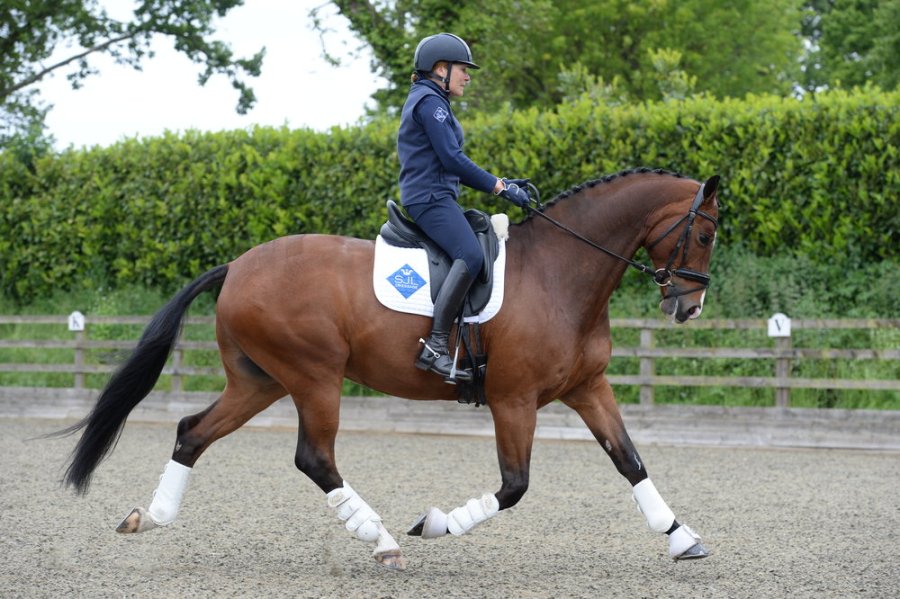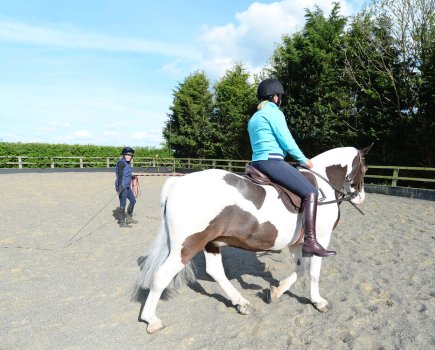Increased impulsion and core strength lead to better engagement all round. Event rider Alex Whewall suggests three exercises to engage your horse’s hindquarters and get their core working effectively.
Developing a strong core and back in your horse is very important as this will enable them to carry themselves – and you – better and will allow them to engage their hind end more effectively. Here are three exercises to help create more impulsion and get your horse a little more ‘switched on’.
Exercise 1
Time: 10 minutes
Warming up with a longer, lower and more relaxed contact will encourage your horse to stretch over their back and will help later on when you come to work on engagement.
- I like to ride a serpentine on a relaxed contact in my warm up. Serpentines really help to get your horse bending around your inside leg and they place a focus on balance from the outset.
- It is important to keep the rhythm through the turns and encourage your horse to bend around your inside leg.
- Keep them moving forwards around the turns, but always keep balance in the forefront of your mind.
- As your horse warms up you can start to collect the contact. This will also help them to develop a more collected frame in the serpentines.
Exercise 2
Time: 10 minutes
This isn’t a specific exercise as such, but rather transitions within each pace, such as collecting and lengthening.
- You’re only aiming to move the pace forwards for a few strides before bringing your horse back underneath you. It’s very important not to let them run on.
- When asking them to lengthen and more forwards, it’s crucial that you don’t rush them or allow them to go on the forehand. Don’t get too greedy with it – control the impulsion and just ask for a little bit at a time.
- This is a really good way to help develop your medium trot and canter too.
- You can also do this exercise after polework (exercise 3). The engagement gained through the poles will greatly help your transitions within the pace.
Exercise 3
Time: 10 minutes
Raised polework can help to strengthen your horse’s core muscles and will also help to engage their hindend.
Set it up: I use six trotting poles placed in a straight line, about 4-5 foot, but adjust this depending on the size of your horse.
If you’re riding a green or less experienced horse, raise just two of the poles at a time until they’re all raised.
- Start with the poles on the ground and get your horse used to them being there and to help them read the distance between them.
- Now raise the poles just a couple of inches off the ground. When working with the raised poles you’re looking to pick your horse up a little more in front. I’d recommend using some half-halts on the approach. Aim to feel more cadence in the trot too.
- The raised poles will make your horse use their hindend more and will also help to develop engagement. They’ll start to lift themselves through their core, strengthening their muscles and working more across their back.
- You want to be feeling that your horse is starting to sit a little more on their hindend, almost as if they’re tucking their bottom underneath them.
The next step: To advance the exercise, add an extra raised pole at 90 degrees at either end of the line of six poles. Turn in over the first 90-degree pole, ensuring that your horse is bent around your inside leg, then curve around onto the line of raised poles, go straight and rise rhythmically through the line, then curve out over the final 90-degree pole.
Meet the expert: Alex Whelwall is an international event rider who has competed up to 5 level. He won the Smith & Williamson intermediate championship at the Festival of British Eventing in 2016.
Check out our subscription offer









